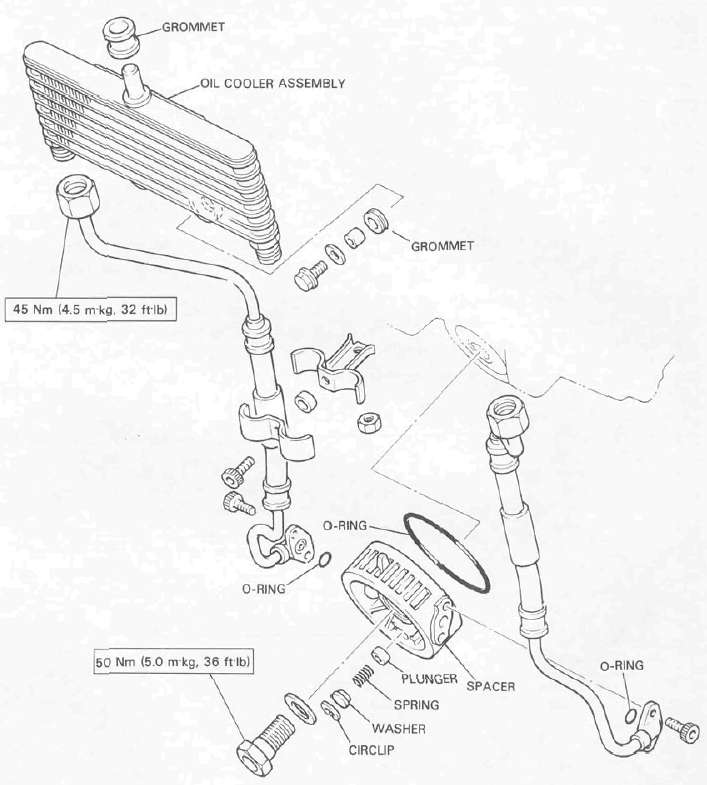Chapter 3. Engine Overhauling
Chapter 3. Engine OverhaulingEngine Removal
Engine RemovalENGINE REMOVAL
NOTE: It is not necessary to remove the engine in order to remove the cylinder head, cylinder, or pistons.
Preparation for removal
1. All dirt, mud, dust and foreign material should be thoroughly removed from the exterior of the engine before removal and disassembly. This will help prevent any harmful foreign material from engine oil.
2. Before the engine removal and disassembly, be sure that you have the proper tools and cleaning equipment so that you can perform a clean and efficient job.
3. During disassembly of the engine, clean and place all of the parts in trays in order of disassembly. This will speed up assembly time and help insure correct reinstall-action of all the engine parts.
4. Place the motorcycle on its center stand. Start the engine and allow it to warm up. Stop the engine and drain the engine oil.
5. Remove the left and right side covers, and remove the left and right oil cooler covers.


Fuel tank
1. Turn the fuel cock to "ON".
2. Remove the seat and remove the fuel tank securing clamp and retainer. Lift the rear end of the fuel tank and disconnect the fuel pipe and vacuum pipe from the cock.

1. Clip 2. Retainer
3. Disconnect the fuel sender unit lead, and remove the fuel tank.
4. Disconnect all connectors from the electrical components holding plate. Remove the electrical components holding plate.
Brake pedal and exhaust pipes
1. Remove the rear brake pedal.
2. Remove the exhaust pipe holding nuts from the cylinder head.


3. Loosen the clamp bolts securing the exhaust pipes to the right and left mufflers. Remove the exhaust pipes.
2. Remove the starter motor lead from the starter relay and disconnect the relay leads from the wire harness.

4. Remove the bolts holding the muffler bracket to the crankcase.

Battery case
1. Remove the negative lead from the battery terminal then remove the positive lead. Remove the battery.

1. Starter motor lead 2. Starter relay
3. Remove the battery case holding bolts and disconnect the rectifier/regulator lead from the wire harness. Then, remove the battery case with the starter relay assembly and rectifier/regulator unit.

Air filter case
1. Remove the clamps holding the carburetors to theair filter case and intake maniholds. Remove the crankcase ventilation hose at the air filter case.

1 Crankcase ventilation hose
2. Remove the bolts holding the air filter case to the frame (upper)

3. Remove the tool box.

4. Remove the starter (CHOKE) and clutch cables from the carburetor assembly.

1 Starter (CHOKE) cable 2 Clutch cable
5. Pull the carburetor assembly to the rear.
6. Disconnect the throttle cable from the carburetor throttle lever and remove the carburetor assembly to the left.

1. Throttle cable
Wiring and cables
1. Disconnect the clutch cable at the crankcase side.

2. Remove the spark plug leads.
3. Disconnect the pick-up coil and A. C. G. lead couplers.
Position the disconnect leads so that they can be safely removed.
CAUTION: The A. C. G. lead, starter motor lead, and pick-up lead are clamped at the cross tube of the frame. Do not forget to remove this clamp before removing the engine.

Oil coolers
1. Remove the oil filter cover from the crankcase.

2. Remove the oil cooler spacer holding bolt and remove the spacer.

1. Oil cooler spacer
3. Remove the oil cooler hose bracket holding nut.

4. Remove the oil cooler holding bolts and clamp. Remove the oil cooler assembly.

Drive shaft joint
1. Remove the coil spring holding the rubber boot.
2. Pull the rubber boot from the drive shaft coupling to expose the joint bolts.
3. Remove the joint bolts on the drive shaft coupling.

Engine removal
1. Remove the front engine mounting bolts and nuts. Remove the brackets.

2. Remove the rear engine mounting bolts and right and left footrests.


3. Remove the muffler securing bolts and remove the mufflers.

4. Slide the engine forward slightly and remove the engine to the right
NOTE: Position a box or other support to the right side of the motorcycle for the assistance when removing the engine.

Engine Disassembly
Engine DisassemblyPickup coil, Shifter, Starter Motor, Generator, and Clutch
Pickup coil, Shifter, Starter Motor, Generator, and ClutchPick-up coil assembly
1. Remove the alien bolt that holds the timing plate.

2. Remove the pick-up coil securing screws and remove the pick-up coil assembly.
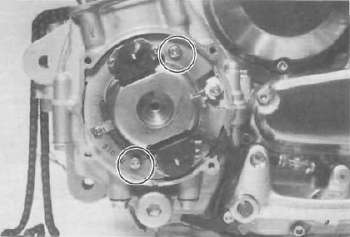
Shifter
1. Remove the change pedal.

2. Remove the left crankcase cover.
3. Remove the shift lever assembly and shift shaft assembly.

1. Shift lever assembly 2. Shift shaft assembly
4. Remove the middle gear case oil level maintaining plug.

1. Remove the starter motor securing bolts and remove the motor assembly.

2. Remove the generator cover and stator coil assembly.


3. Install the rotor holding tool (special tool) on the rotor as shown and remove the rotor holding bolt.

1 Rotor holding tool
4. Insert the holding tool as shown and insert the rotor puller adapter (special tool) into the rotor shaft and screw in the rotor puller (special tool). Remove the rotor.

1. Rotor puller adapter

1. Rotor puller
Clutch
1. Remove right crankcase cover.

2. Release the tension evenly on the 6 mm bolts and remove the clutch pressure plate and clutch springs.

3. Remove the friction plates and clutch plates.
4. Straighten the lock washer tab. Use the clutch boss holder (special tool) to hold the clutch boss and remove the lock nut and lock washer.

1. Clutch boss holder
5. Remove the clutch boss and spacer.


6. Screw in a suitable length of 6 mm bolt into the one of the threaded holes on the collar and pull out the collar and needle bearing from the primary driven gear.

1. Collar 2. Pull
7. Remove the primary driven gear assembly and oil pump drive sprocket

8. Remove the oil collector plate.

Oil pump, Middle gear, and Crankcase
Oil pump, Middle gear, and CrankcaseOil pump removal and disassembly
1. Remove the strainer cover. Note the wire harness clip position.
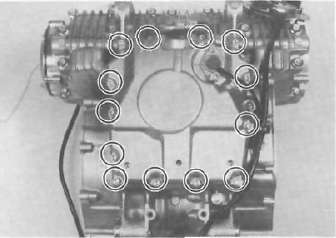
2. Remove the oil pump secruing bolts and remove the sprocket cover and oil pump assembly.
CAUTION: Do not attempt to remove the strainer screen as it is permanently fitted onto the pump housing. If the pump housing and/or any parts of the pump are damaged, the pump assembly must be replaced with a new one.
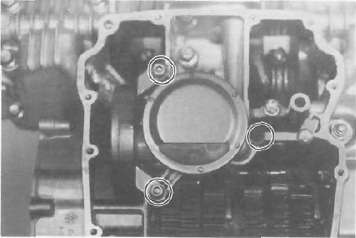
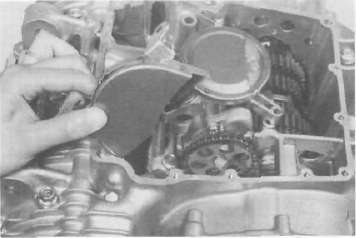
3. Remove the oil pump driven sprocket.
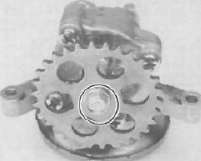
4. Remove the oil pump cover and rotor assembly.
5. Remove the pressure relief valve, spring and plunger.
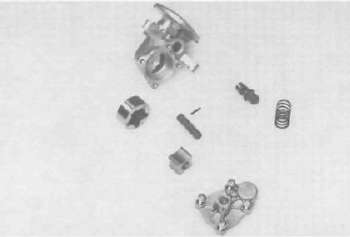
Middle gear
1. Remove the middle driven gear housing holding bolts.
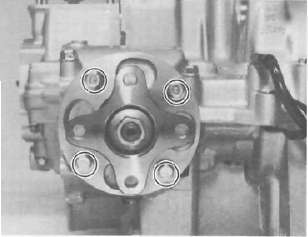
2. Remove the middle driven gear housing assembly and shims.
NOTE: If it is difficult to remove housing assembly, loosen the two crankcase bolts located near the middle driven gear housing.
3. Remove "TORX" screws holding the middle drive gear assembly.
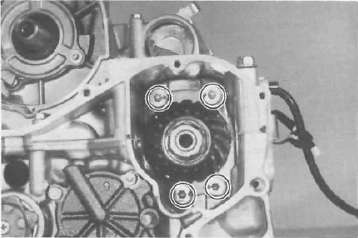
4. Remove the bearing retainers.
Crankcase disassembly
1. Remove the upper crankcase bolts, starting the highest numbered bolt. Turn over the engine and remove the lower crankcase bolts.
CRANKCASE TIGHTENING SEQUENCE
LOWER CASE
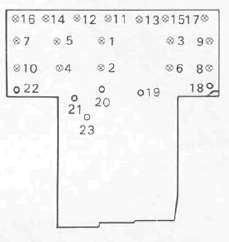
UPPER CASE
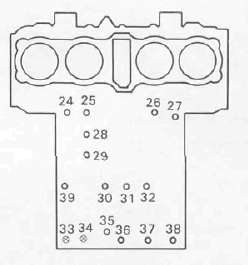
Tightening Torque
8 mm bolt: 24 Nm (2.4 mkg, 17 ft-lb) O .... 6 mm bolt: 12 Nm (1.2 mkg. 8.7 ft-lb)
Separate the lower case from the engine. Use a soft rubber hammer to carefully separate the crankcase.
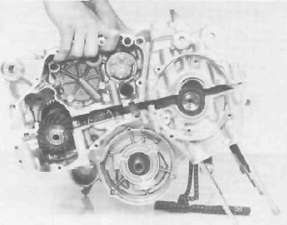
Upper crankcase
1. Remove the middle drive gear and damper assqmbly.
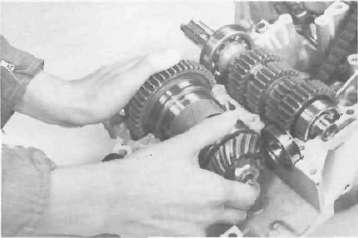
2. Remove the transmission main shaft assembly.
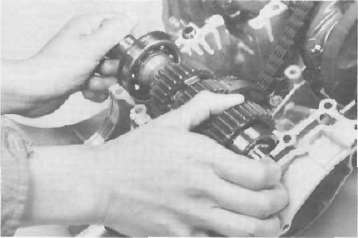
3. Remove the A. C. G. shaft cover.
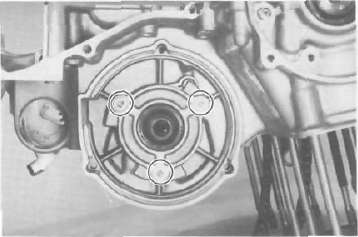
4. Remove the oil spray nozzle.
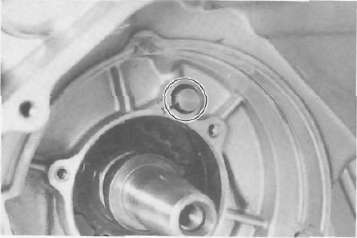
5. Carefully remove the A. C. G. shaft from the gear.
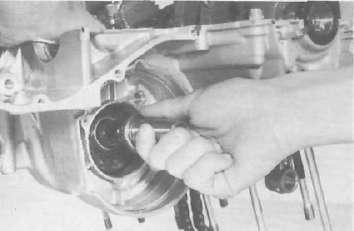
6. Remove the gear from the chain.
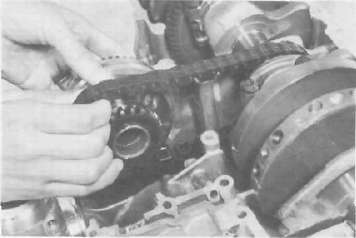
7. Straighten the lock washer tab and remove the bolt securing the starter idle gear shaft. Remove the shaft and starter idle gear.
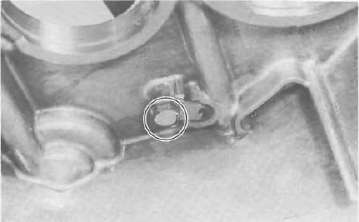
8. Remove the crankshaft.
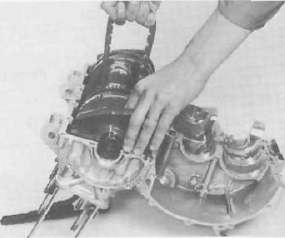
Lower crankcase
1. Remove the dowel pin and "O-ring".
2. Remove the shift fork guide bar and shift forks. The shift forks are identified by numbers cast on their sides.
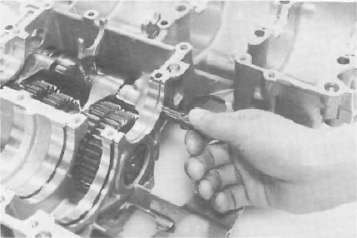
3. Remove the bolt securing the shift cam locating pin and remove the stopper plate and locating pin.
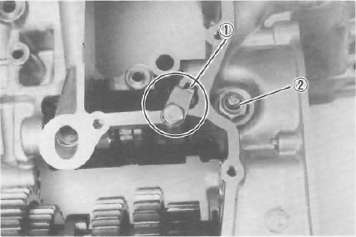
1. Shift cam locating pin 2. Neutral switch
4. Remove the neutral switch.
5. Pull out the shift cam.
6. Remove the driven shaft bearing cover holding screws and remove the bearing cover.
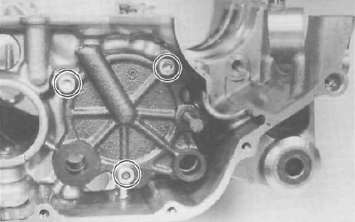
7. Remove the 5th wheel gear from the driven shaft and pull out the driven shaft assembly.
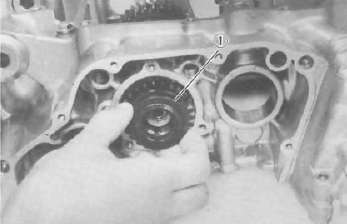
1. 5th wheel gear
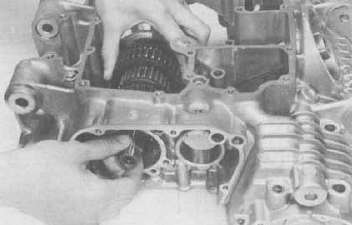
Cylinder Head, Cylinder and Piston
Cylinder Head, Cylinder and PistonCylinder head and cylinder
1. Remove the cylinder head cover.
2. Remove the left crankcase cover (pickup coil cover).
3. Remove the cam chain tensioner.

4. Use a 19 mm wrench on the timing plate flats to rotate the crankshaft counterclockwise until the engine is at Top Dead Centre.

CAUTION: Never use an alien wrench to rotate the crankshaft. Always use the 19 mm flats provided on the timing plate to rotate this engine.
5. Remove the four cam sprocket bolts.

6. Slip each sprocket off its mounting boss on the cam.
CAUTION: From this point on, do not rotate the cam shaft or valve damage may occur. On this, it is not necessary to break the cam chain. However, it can be broken if so desired. It is easier to disassemble the engine without separating the chain.
7. Remove the cam chain guide.

1. Cam cham guide
8. Remove the cam caps. Note the location ofthe cam caps as shown. Directional arrows are cast on each cap and point toward the clutch side.

9. Fasten safety wire to the cam chain to prevent its falling into the crankcase cavity.
Slide the camshafts and sprockets from under the chain and remove the camshafts and sprockets.

10. Remove the front cam chain guide.

1. Front cam chain guide
11. Remove the spark plugs.
12. Remove the cylinder head bolts and nuts in the numerical order as shown. Start by loosening each nut 1/2 turn until all of the nuts are loose. Remove the cylinder head.


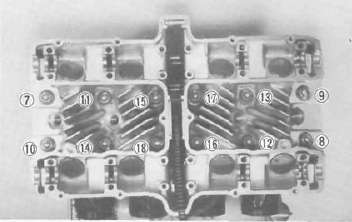
13. Remove the front cylinder holding nut and remove the cylinder assembly. It may be necessary to tap the cylinder lightly to loosen it from the base gasket.
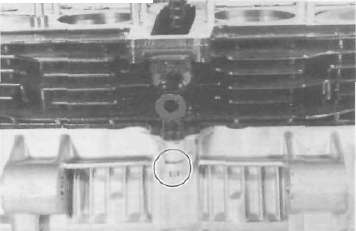
14. Remove the rear cam chain guide by loosening the holding bolt.

1. Hoiding bolt 2 Rear cam chain guide
Cylinder head disassembly
1. Remove the valve lifters and pads. Be careful not to scratch the lifter bodies or lifter bores in the cylinder head. Be very careful to identify each lifters position so that it may be returned to its original place.

1 Valve lifter 2. Adjusting pad
2. Mount the valve spring compressor on the head and depress each valve spring. Take out the retainer and valve spring with tweezers.

1. Valve spring compressor
3. Remove valves.
NOTE: Deburr any deformed valve stem end. Use an oil stone to smooth the stem end. This will help prevent damage to the valve guide during valve removal.

DEBURR VALVE STEM
4. Use a small box to hold the parts and identify the original position of each lifter and valve. Be very careful not to mix the location of these components.
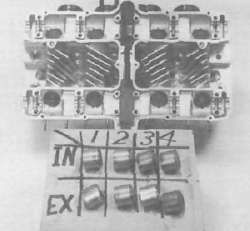
Piston
1. Make each piston to aid in reassembly.
2. Place a clean towel or rag into the cranckcase to keep circlips and material from falling into the engine.
3. Remove piston pin clips, piston pins, and pistons.

Engine Inspection and Repair
Engine Inspection and RepairCylinder, Head and Valves
Cylinder, Head and ValvesCylinder head cover
Place head cover on a surface plate. There should be no warpage. Correct by re-surfacing as follows:
Place # 400 or # 600 grit wet sandpaper on surface plate and re-surface head cover using a figure-eight sanding pattern. Rotate head cover several times to avoid removing too much material from one side.
Cylinder head
1. Using a rounded scraper, remove carbon deposits from combustion chamber. Take care to avoid damaging spark plug threads and valve seats. Do not use a sharp instrument. Avoid scratching the aluminum.
2. Check the cylinder head warpage with a straight edge as shown.
The warpage should not exceed the specified limit, it necessary resurface. If the warpage exceeds allowable limit, the cylinder head should be replaced with a new one.
Cylinder head warpage: less than 0.03 mm (0.0012 in) Allowable limit: 0.25 mm (0.010 in)
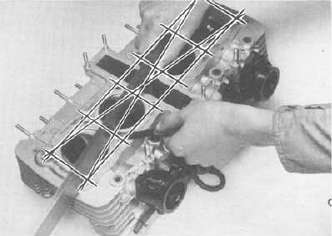
Valve, valve guide, and valve seat
1. Check the valve face and the stem end for wear. If the valve face and/or the stem end are pitted or worn, regrind the valve with a valve refacer. Replace the valve if any dimension exceeds the specifications in the illustration.
INTAKE/EXHAUST VALVE
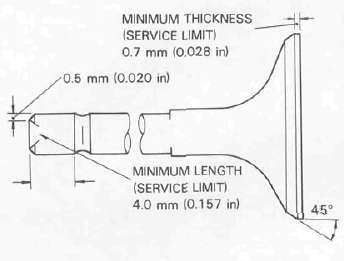
2. Valve stem wear must be measured and then combined with valve guide measurements to guide clearance. This clearance must be within tolerances. If it exceeds the maximum limit, then replace either or both valve and guide, as necessary.
|
|
Valve Stem Clearance |
Maximum |
|
Intake |
0.010 —0.037 mm (0.0004 -0.0015 in) |
0.10 mm (0.004 in) |
|
Exhaust |
0.025 — 0.052 mm (0.0010 -0.0020 in) |
0.12 mm (0.005 in) |
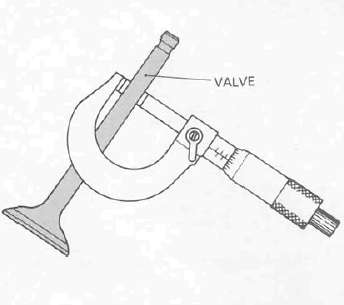
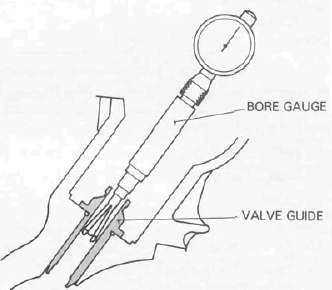
3. Valve stem end
Inspect the end of the valve stem. If the end appears to be ''mushroomed" or has a larger diameter than the rest of the stem, the valve, valve guide, and oil seal should be replaced.
4. Turn valve on "V" blocks and measure the amount of stem runout with a dial gauge. If it exceeds the maximum limit, replace the valve.
Maximum valve stem runout: 0.03 mm (0.0012 in)
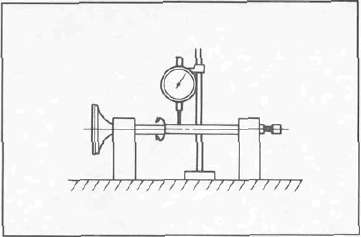
5. Valve guide and valve oil seal replacement
If oil leaks into the cylinder through a valve due to a worn valve guide, or if a valve is replaced, the valve guide should also be replaced.
NOTE: The valve oil seal should be replaced whenever a valve is removed or replaced.
a. Measure valve guide inside diameter with a small bore gauge. If it exceeds the limit replace with an oversize valve guide.
Guide diameter (I. D.): Limit: 7.10 mm (0.280 in)
b. To ease guide removal and reinstallation, and to maintain the correct interference fit heat the head to 100 °C (212°F). Use an oven to avoid any possibility of head warpage due to uneven heating.
c. Use the appropriate shouldered punch (special tool) to drive the old guide out and drive the new guide in.
NOTE: When a valve guide is replaced, the 0-ring should also be replaced.
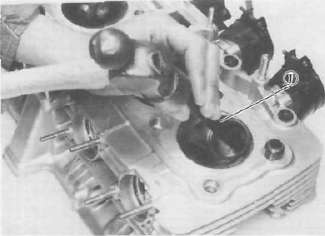
1. Valve guide remover
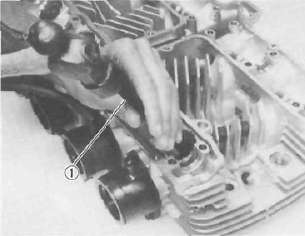
1. Valve guide installer
d. After installing the valve guide, use the 7 mm reamer (special tool) to obtain the proper valve guide to valve stem clearance.
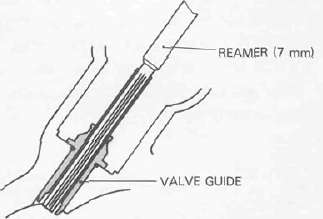
e. After installing the valve guide in the cylinder head, the valve seat must be recut. The valve should be lapped to the new seat.
6. Grinding the valve seat a. The valve seat is subject to severe wear. Whenever the valve is replaced or the valve face is re-surfaced (see CAUTION) the valve seat should be re-surfaced at a 45° angle. If a new valve guide has been installed the valve seat must be recut to guarantee complete sealing between the valve face and seat.
Remove just enough material to achieve a satisfactory seat.
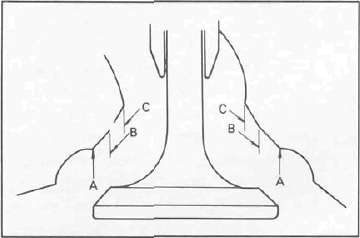
CAUTION: If the vatve seat is obviously pitted or worn, it should be cleaned with a valve seat cutter. Use the 45° cutter, and when twisting the cutter, keep an even downward pressure to prevent chatter marks.
If cutting section "A" of the valve seat, use 30° cutter. If cutting section "B", use the 45° cutter. If cutting section "C", use 60° cutter. b. Measure valve seat width. Apply mechanic's bluing dye (such as Dykem) to the valve face and valve seat, apply a very small amount of fine grinding compound around the surface of the valve face insert the valve into position, and spin the valve quickly back and forth. Lift the valve, clean off all grinding compound, and check valve seat width. The valve seat and valve face will have removed bluing wherever they contacted each other. Measure the seat width with vernier calipers. It should measure approximately 0.9 — 1.1 mm (0.035 — 0.043 in). Also, the seat should be uniform in contact area. If valve seat width varies, or if pits still exist, further cutting will be necessary.
|
|
Standard Width |
Wear Limit |
|
Seat width |
0.9 —1.1 mm (0.035 -0.043 in) |
2.0 mm (0.080 in) |
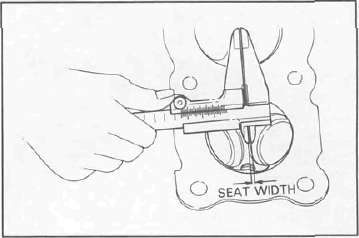
c. If the valve seat is uniform around the perimeter of the valve face, but is too wide or not centered on the valve face, it must be altered. Use either the 30°, 45° or 60° cutters to correct the improper seat location in the manner described below:
1) If the valve face shows that the valve seat is centered on the valve face, but too wide, then lightly use both the 30° and the 60° cutters to reduce the seat width to 0.9 —1.1 mm (0.035 —0.043 in).
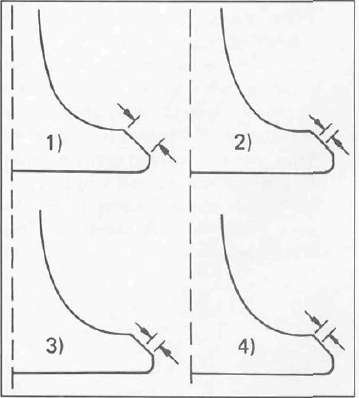
2) If the seat shows to be in the middle of the valve face, but too narrow, use the 45° cutter until the width equals 0.9 ~~ 1.1 mm (0.035 —0.043 in).
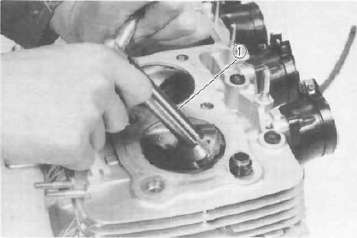
1. Valve seat cutter
3) If the seat is too narrow and right up near the valve margin, then first use the 30° cutter and then the 45° cutter to get the correct seat width.
4) If the seat is too narrow and down near the bottom edge of the valve face, then first use the 60° cutter and then the 45° cutter.
7. Lapping the valve/valve seat assembly
a. The valve/valve seat assembly should be lapped if neither the seat nor the valve face are severely worn.
b. Apply a small amount of coarse lapping compound to valve face. Insert the valve into the head. Rotate the valve until the valve and valve seat are evenly polished. Clean off the coarse compound, then follow the same procedure with fine compound.
Continue lapping until the valve face shows a complete and smooth surface all the way around. Clean off the compound material. Apply bluing dye to the valve face and seat and rotate the valve face for full seat contact which is indicated by a grey surface all around the valve face where the bluing has been urbbed away.
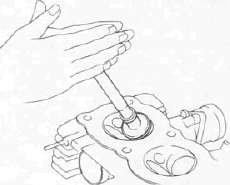
c. Valve leakage check
After all work has been on the valve and valve seat, and all head parts have been assembled, check for proper valve/valve seat sealing by pouring solvent into each of the intake ports, then the exhaust ports. There should be no leakage past the seat. If fluid leaks, disassemble and continue to lap with fine lapping compound. Clean all parts thoroughly, reassemble and check again with solvent. Repeat this procedure as often as necessary to obtain a satisfactory seal.
Valve spring and lifters
1. Checking the valve springs
a. This engine uses two springs of different sizes to prevent valve float or surging. The valve spring specifications show the basic value characteristics.
b. Even though the spring is constructed of durable spring steel, it gradually loses some of it's tension. This is evidenced by a gradual shortening of free length. Use a vernier caliper to measure spring free length. If the free length of any spring has decreased more than 2 mm (0.080 in) from its specification replace it
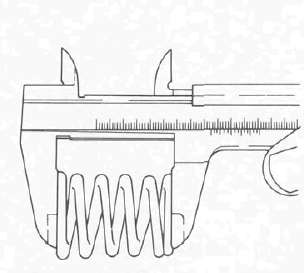
c. Another symptom of a fatigued spring is insufficient spring pressure when compressed. This can be checked using a valve spring compression rate gauge. Test each spring individually. Place it in the gauge and compress the spring first to the specified compressed length with the valve closed (all spring specifications can be found in the previous section, Valve spring), then to the length with the valve open. Note the poundage indicated on the scale at each setting. Use this procedure with the outer springs, then the inner springs.
NOTE: All valve springs must be installed with larger pitch upward as shown.
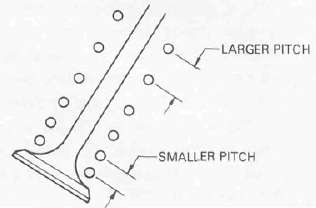
|
Valve Spring Specifications |
||
|
OUTER |
INNER |
|
|
Free length |
39.5 mm (1.555 in) |
35.9 mm (1.413 in) |
|
Installed length (valve closed) |
34.0 mm (1.339 in) |
31.0 mm (1.220 in) |
|
Installed pressure |
17.6 -20.6 kg (38.8 - 45.4 lb) |
8.1 -9.9 kg (17.9 -21.8 lb) |
|
Allowable tilt from vertical |
2.5° |
— |
2. Valve lifter a. Check each valve lifter for scratches or other damage. If the lifter is damaged in any way, the cylinder head surface in which it rides is probably also damaged. If the damage is severe, it may be necessary to replace both the lifter and the cylinder head.
NOTE: For proper valve lifter-to-head clearance, always install lifters on their original valves.
Camshafts, cam chain and cam sprockets
1. Camshaft
a. The cam lobe metal surface may have a blue discoloration due to excessive friction. The metal surface could also start to flake off or become pitted.
b. If any of the above wear conditions are readily visible, the camshaft should be replaced.
c. Even though the cam lobe surface appears to be in satisfactory condition, the lobes should be measured with a micrometer. Cam lobe wear can occur without scarring the surface. If this wear exceeds a pre-determined amount, valve timing and lift are affected. Replace the camshaft if wear exceeds the limits.
d. Install the camshaft on the cylinder head. Place a strip of Plastigage between camshaft and camshaft cap as illustrated (lengthwise along camshaft). Tighten the nuts with specified torque. Remove the camshaft cap and determine the clearance by measuring the width of the flattened Plastigage.
Cap nut tightening torque: 10 Nm (1.0 rrvkg, 7.2 ft lb)
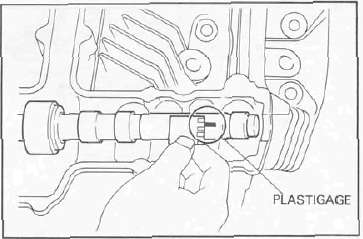
NOTE: Do not turn camshaft when measuring clearance with plastigage.
Camshaft-to-cap clearance:
Standard: 0.020 — 0.054 mm
(0.0008 —0.0021 in) Maximum: 0.160 mm (0.006 in)
If the camshaft-to-cap clearance exceeds specification, measure camshaft bearing surface diameter.
Bearing surface diameter: Standard: 24.967 — 24.980 mm (0.9830 - 0.9835 in)
1) If the camshaft diameter is less than specification, causing excessive clearance, replace the camshaft.
2) If the camshaft is within specificaton and camshaft-to-cap clearance is excessive, replace the cylinder head.
2. Cam chain
Except in cases of oil starvation, the cam chain wears very little. If the cam chain has stretched excessively and it is difficult to keep the proper cam chain tension, the chain should be replaced.
3. Cam sprockets
Check cam sprockets for obvious wear.
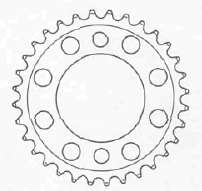
4. Cam chain dampers and tensioner
Inspect the top cam chain damper (stopper guide) and two (2) vertical (slipper-type) dampers for excessive wear. Any that shows excessive wear should be replaced. Worn dampers may indicate an improperly adjusted or worn-out cam chain.
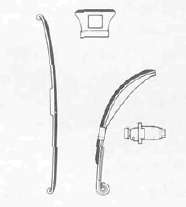
Cylinder
1. Inspect the cylinder walls for scratches. If vertical scratches are evident, the cylinder wall should be rebored or the cylinder should be replaced.
2. Measure cylinder wall wear as shown. If wear is excessive, compression pressure will decrease. Rebore the cylinder wall and replace the piston and piston rings. Cylinder wear should be measured at three depths with a cylinder bore gauge. (See illustation.)
|
|
Standard |
Wear Limit |
|
Cylinder bore |
67.00 mm (2.638 in) |
67.10 mm (2.642 in) |
|
Cylinder taper |
- |
0.05 mm (0.002 in) |
|
Cylinder out-of-round |
- |
0.01 mm (0.0004 in) |
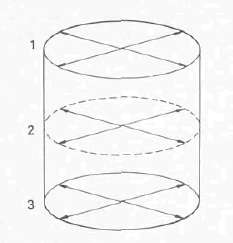
If the cylinder wall is worn more than the wear limit, it should be rebored.
Piston, Rings and Crankshaft
Piston, Rings and CrankshaftPiston and piston rings
1. Piston
a. Measure the outside diameter of the piston at the piston skirt. Measurement should be made at a point 7.8 mm (0.307 in) above the bottom edge of the piston. Place the micrometer at right angles to the piston pin.
|
Size |
|
|
Oversize 1 |
- |
|
Oversize 2 |
67.50 mm (2.657 in) |
|
Oversize 3 |
- |
|
Oversize 4 |
68.00 mm (2.677 in) |

b. Determine piston clearance as follows: Minimum bore measurement
- Maximum piston measurement = Piston clearance
EXAMPLE:
67.00 mm (2.6378 in)
- 66.96 mm (2.6362 in) = 0.04 mm (0.0016 in)
Piston clearance
Piston clearance:
Standard: 0.030 — 0.050 mm
(0.0012 —0.0020 in) Service limit: 0.1 mm (0.0039 in)
c. Piston ring/ring groove fit must have correct clearance. If the piston and ring have already been used, the ring must be removed and the ring groove cleaned of carbon. The ring should be then reinstalled. Use a feeler gauge to measure the gap between the ring and the land.
|
Side clearance |
Top |
0.03 — 0.07 mm (0.0012 -0.0028 in) |
|
2nd |
0.02 — 0.06 mm (0.0008 -0.0024 in) |

2. Piston ring a. The oversize top and middle ring sizes are stamped on top of the ring.
|
Oversize 1 |
- |
|
Oversize 2 |
0.50 mm (0.0197 in) |
|
Oversize 3 |
- |
|
Oversize 4 |
1.00 mm (0.0394 in) |
b. The expander spacer of the bottom ring (oil control ring) is color-coded to identify sizes.
The color mark is painted on the expander spacer.
Run-out limit: 0.03 mm (0.0012 in)
|
Size |
Color |
|
Oversize 1 |
- |
|
Oversize 2 |
Blue |
|
Oversize 3 |
- |
|
Oversize 4 |
Yellow |
c. Insert a ring into the cylinder, and push it approximately 20 mm (0.8 in) into the cylinder. Push the ring with the piston crown so the ring will be at a right angle to the cylinder bore. Measure the ring end gap with a feeler gauge. If the end gap exceeds tolerance, replace the whole set of rings.
NOTE: The end gap on the expander spacer of the oil control ring is unmeasurable. If the oil control ring rails show excessive gap, all three components should be replaced.
|
Standard |
Limit |
|
|
Top/2nd ring |
0.15 — 0.35 mm (0.0059 -0.0138 in) |
1.0 mm (0.039 in) |
|
Oil control (Rails) |
0.3 — 0.9 mm (0.012 —0.035 in) |
1.5 mm (0.059 in) |
Piston pin
1. Apply a light film of oil to pin. Install in connecting rod small end. Check for play. There should be no noticeable vertical play. If play exists, check connecting rod small end for wear. Replace pin and connecting rod as required.
2. The piston pin should have no noticeable free play in piston. If the piston pin is loose, replace the pin and/or the piston.
Crankshaft
1. Crankshaft run-out
Support the crankshaft at both ends on V-blocks. Measure the amount of crankshaft run-out on the main bearing journals with a dial gauge while rotating crankshaft.
If run-out exceeds limit, replace crankshaft.

2. Inspection of bearings
Check the bearings. If the inner or outer surface is burned, flaked, rough, scratched or worn, the bearings should be replaced.
3. Measuring main bearing oil clearance
a. Clean all crankshaft and crankcase journal surfaces.
b. Place upper crankcase half upside-down on a bench. Install bearing inserts into top crankcase.
c. Install crankshaft into upper crankcase.
d. Place Plastigage on crankshaft journal surface to be inspected.
NOTE: Do not move crankshaft until clearance check has been completed.

e. Install bearings into bottom crankcase. Carefully, place lower crankcase onto upper crankcase.
f. Install crankcase holding bolts 1 through 10. Tighten to full torque in torque sequence cast on crankcase.
Crankcase torque (8 mm bolt): 24 Nm (2.4 mkg, 17 ft-lb)
g. Remove bolts in reverse assembly order (10, 9, 8 ... etc.)
h. Carefully remove lower crankcase. Measure width of Plastigage on crankshaft journals to determine clearance.
Main bearing oil clearance: 0.040 — 0.064 mm (0.0016 -0.0025 in)
4. Crankshaft main bearing selection a. Numbers used to indicate crankshaft journal sizes are stamped on the L.H. crank web. The first five (5) are main bearing journal numbers, starting with the left journal. The four (4) rod bearing journal numbers follow in the same sequence.

The upper crankcase half is numbered 4, 5, or 6 as shown.

1. Main bearing numbers
b. The connecting rods are numbered 4 or 5. The numbers for rods are stamped with ink on the rod itself.

c. The proper bearing selection is made by subtracting the crankshaft journal number from the crankcase or rod size number. Use the color code to choose the proper bearing. EXAMPLE:
Rod No. (Minus) Journal No. = Bearing No.
5-2 = 3 No. 3 bearing is Brown. Use Brown bearing inserts.
|
BEARING COLOR CODE |
|
|
No. 1 |
Blue |
|
No. 2 |
Black |
|
No. 3 |
Brown |
|
No. 4 |
Green |
|
'No. 5 |
Yellow |
" For crankshaft main bearing only.
d. When assembling, apply a liberal coat of motor oil to all bearing surfaces.
NOTE: When applying final torque to the rod caps, observe the following procedures.
e. Apply molybdenum disulfide grease to connecting rod bolt threads. Apply tor-que evenly to both ends of the cap. While tightening, if a torque of 38 Nm (3.8 m kg, 27 ft-lb) or more is reached, DO NOT STOP tightening until final torque is reached. If tightening is interrupted between 35 Nm (3.5 mkg, 25ft-lb) and 41 Nm (4.1 nrvkg. 30 ft-lb), loosen the nut to less than 30 Nm (3.0 nrvkg, 22 ft-lb) and start again. Tighten to full torque specification without pausing.
Rod bearing oil clearance: 0.016 — 0.040 mm (0.0006 —0.0016 in)
Oil pump, Clutch and Starter drive
Oil pump, Clutch and Starter driveOil pump
1. Check the clearance between housing and outer rotor.
Standard clearance: 0.03 — 0.09 mm (0.0012 — 0.0035 in)
2. Check the clearance between outer rotor and inner rotor.
Standard clearance: 0.03 — 0.08 mm (0.0012 — 0.0031 in)
3. Check the plunger for scratches and wear.

Clutch
1. Clutch housing
a. Check the dogs on the clutch housing. Look for cracks and signs of galling on edges. If damage is moderate, deburr. If severe, replace the clutch housing.
NOTE: Galling on the friction plate dogs of the clutch housing will cause erratic clutch operation.
b. Check the clutch housing bearing for damage. If damaged replace bearing.
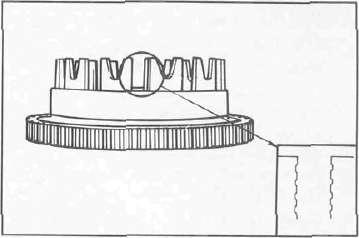
2. Clutch boss
a. The clutch boss contains a built-in damper beneath the first clutch plate (clutch plate 2). It is not normally necessary to remove the circlip and disassemble the built-in damper unless there is serious clutch chattering.
b. Check splines on clutch boss for galling. If damage is slight to moderate, deburr; if it is severe, replace clutch boss.
NOTE: Galling on clutch plate splines will cause erratic operation.
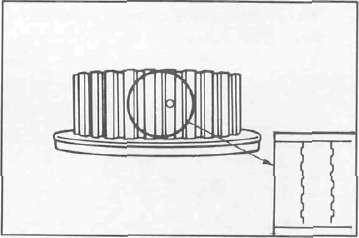
3. Friction and clutch plates
Check clutch steel plates and friction plates for heat damage. Measure friction plate thickness at 3 or 4 points. Check each clutch plate for signs of heat damage and warpage. Place on surface plate (plate glass is acceptable) and use feeler gauge as illustrated. If warpage exceeds tolerance, replace.
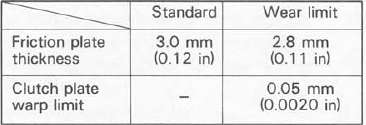
NOTE: For optimum performance, if any friction or clutch plate requires replacement it is advisable to replace the entire set.

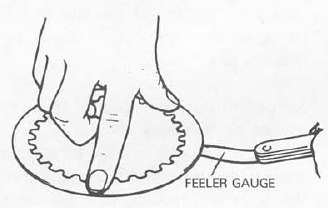
4. Clutch actuating mechanism
a. Check the pull rod rack gear teeth for wear and damage, replace if damaged.
b. Check the pull rod thrust bearing for damage, replace if damaged.
c. Check the clutch lever shaft pinion gear teeth for damage, replace if damaged.

1 Plate washer 2. Thrust bearing 3. Pull rod
5. Clutch springs
Measure the clutch spring free length. Replace the springs as a set if any is less than minimum free length.
Clutch spring minimum length: 43.0 mm (1.69 in)
Transmission
1. Inspect each shift fork for signs of galling on gear contact surfaces. Check for bending. Make sure each fork slides freely on its guide bar.
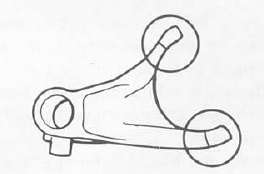
2. Roll the guide bar across a surface place. If the bar is bent, replace.
3. Check the shift cam grooves for signs of wear or damage. If any profile has excessive wear and/or damage, replace cam.
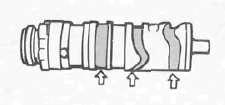
4. Check the cam followers on each shift fork for wear. Check the ends that ride in the grooves in the shift cam. If they are worn or damaged, replace the shift forks.

5. Check shift cam dowel pins and side plate for looseness, damage or wear. Replace as required.
6. Check the shift cam stopper plate and circlip and stopper for wear. Replace as required.
7. Check the transmission shafts using a centering device and dial gauge. If any shaft is bent beyond specified limit, replace shaft.
Maximum run-out: 0.08 mm (0.0031 in)
8. Carefully inspect each gear. Look for signs of obvious heat damage (blue discoloration). Check the gear teeth for signs of pitting, galling or other extreme wear. Replace as required.
9. Check to see that each gear moves freely on its shaft
10. Check to see that all washers and clips are properly installed and undamaged. Replace bent or loose clips and bent washers.
11. Check to see that each gear properly engages its counterpart on the shaft. Check the mating dogs for rounded edges, cracks, or missing portions. Replace as required.
Starter drives
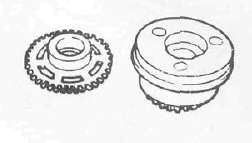
1. Electric starter clutch and gears
a. Check the surface of the idle gear for pitting or other damage. If severe, replace the gear.
b. Check the spring caps and the springs for deformation or damage. If severe, replace as necessary.
c. Check the starter clutch bolts (alien screw) for looseness. If loose, remove the bolts and replace with new bolts. Apply a thread locking compound such as "LOCTITE" to threads and tighten to specified torque. Stake over the end of the bolts.
Starter clutch bolt torque: 25 Nm (2.5 m-kg, 18 ft lb)
d. Check the "HY-VO" chain for damage and wear, replace if damaged.
e. Check the "HY-VO" chain guide for damage, replace if damaged.
Crankcases and strainer cover
I. Check crankcase for cracks or other
damage. I. Clean all oil passages and blow out with
compressed air.
3. Strainer cover: Apply a thread locking compound such as "LOCTITE" to strainer cover bolts during reassembly.
Bearing and oil seals
1. After cleaning and lubricating bearings, rotate inner race with a finger. If rough spots are felt, replace the bearing.
NOTE: Bearings are most easily removed or installed if the housings are first heated to approximately 95° - 125°C (200° - 250°F). Bring the case up to proper temperature slowly. Use an oven to avoid distortion.
2. Check oil seal lips for damage and wear. Replace as required.
Middle gear
Middle gearMiddle gear
1. Damper disassembly
NOTE: Disassembly of the middle gear damper requires the damper compressor (special tool) and a hydraulic press.
a. Place the middle drive shaft in a press with the damper compressor (special tool) in place as shown.

1. Damper compressor 2. Press
b. Press the damper spring and remove the spring retainers.
c. Remove the spring seat, spring, and damper cams from the drive shaft.
2. Inspection
a. Inspect the damper cam surfaces. Check for smooth cam action and excessive wear on the cam surface. If cam surface is severely worn, replace damper assembly.

b. Inspect the damper spring for fatigue, wear and damage. Replace as necessary.
c. Check bearing movement for damage to balls, rough spots, bearing looseness. Inspect gear teeth. If any gear tooth and/ or bearing are damaged, the gear set and/or bearing must be replaced.
3. Middle drive/driven shaft bearing removal
CAUTION: The following procedures should be performed only if the bearing or gear is to be replaced.
a. Middle drive gear
1) Bend down the lock washer of the nut with a suitable center punch.
2) Support the middle drive shaft in a vise securely.
Remove the drive pinion holding nut. Then, remove the drive pinion and bearing.


b. Middle driven gear
1) Support the drive flange in a vise securely. Remove the flange holding nut.
CAUTION: This holding nut has been locked with a thread locking compound, when reinstalling do not forget to apply a thread locking compound such as "LOCTITE" and punch.
2) Remove the drive flange from the driven shaft.
NOTE: Driven gear shaft bearing should be replaced together with a bearing housing.

Middle gear reassembly
a. Middle drive gear bearing and damper
1) Install the bearing onto the drive pinion and secure it with a new lock nut.
Tightening torque:
110 Nm (11.0 rrvkg, 80 ft lb)
2) Stake the lock washer of the nut to the slot on the drive pinion.
3) Install the driven damper cam onto the drive pinion shaft with the cam lobes positioned 90° from the row of shaft oil holes. Positioning tolerance is ± 1 spline (15°) from the 90° position.
4) Install the drive damper cams, spring, spring seat, and retainers using a press and the damper compressor.

1. Oil hole
b. Middle driven gear
1) Install the new bearing housing assembly onto the driven pinion shaft
CAUTION: Do not press the bearing outer race. Always press the inner race with care when installing.
2) Install the drive flange and new "0-ring" onto the driven gear shaft. Apply a thread locking compound such as "LOCTITE" tothe shaft threads and tighten the nut to the specified torque.
Tightening torque:
110Nm (11.0 m-kg, 80 ft lb)
3) Stake the nut with a center punch to lock as shown.
4) Install the new "O-ring" onto the bearing housing.

Engine Assembly and Adjustment
Engine Assembly and AdjustmentImportant information
1. All gaskets and seals should be replaced when an engine is overhauled. All gasket surfaces and oil seal lips must be cleaned.
2. Properly oil all mating engine and transmission parts and bearings during reassembly.
3. All circlips should be inspected carefully before reassembly. Always replace piston pin clips after one use. Replace distorted circlips. When installing a circlip, make sure that the sharp edged corner is positioned opposit to the thrust it receives. See the sectional view below.
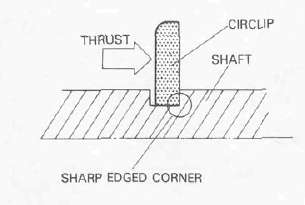
4. All lock washers/plates and cotter pins must be replaced when they are removed. Lock washer/plate tab(s) should be bent over along the bolt or nut flat(s) after tightening the bolt or nut properly (see illustration).
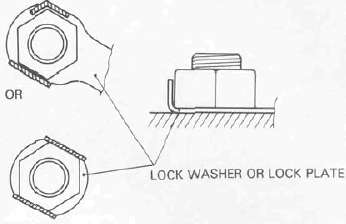
Cotter pins should be replaced after one use.
Upper Crankcase Assembly
Upper Crankcase AssemblyCRANKSHAFT/PISTON
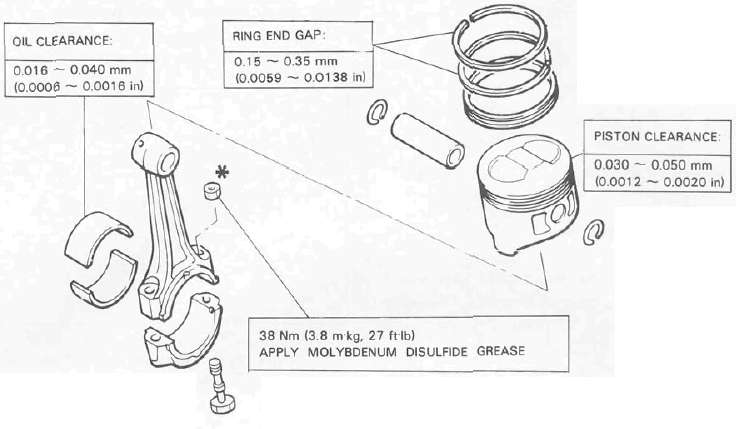
. WHEN INSTALLING THE CONNECTING ROD. BE SURE THAT THE SECURING NUTS ARE ON TOP.
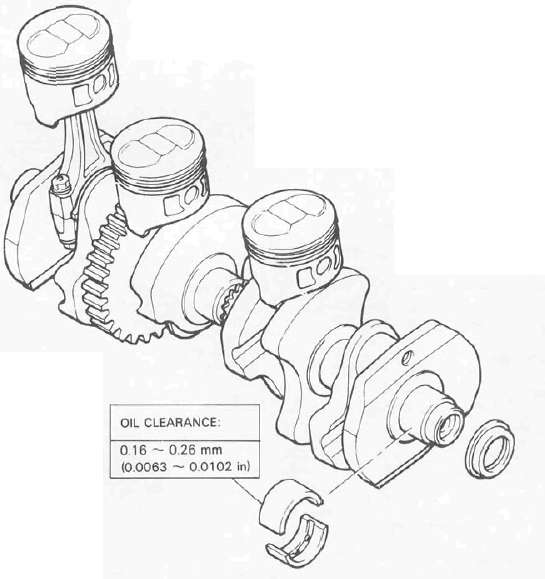
Engine assembly
1. Upper crankcase a. Install the connecting rods onto the crankshaft with the proper connecting rod bearings and apply molybedenum disulfide grease to the bolt threads. Apply torque evenly to both ends of the cap.
CAUTION: While tightening, if a torque of 38 Nm (3.8 mkg, 27 ft-lb) or more is reached, DO NOT STOP tightening until final torque is reached.
If tightening is interrupted between 35 Nm (3.5 mkg, 25 ft-lb) and 41 Nm (4.1 mkg, 30 ft-lb), loosen the nut to less than 30 Nm (3.0 mkg, 22 ft-lb) and start again. Tighten to full torque specification without pausing.
CAUTION: When installing the connecting rod, be sure that the securing nuts are on top. Otherwise, engine damage will result.
Rod cap torque: 38 Nm (3.8 mkg, 27 ft-lb)

b. Install the proper crankshaft main bearings into the crankcase and place the crankshaft. Oil the bearings liberaly.
NOTE: Do not forget to install the crankshaft oil seal (L.H.), blind plug (R.H.), "HY-VO" chain and cam chain on the crankshaft before installing. Also, install the chain guide into upper crankcase if removed.
c. Install the starter idle gear, shaft, stopper plate, and new lock plate. Tighten the bolt securely and bend the lock tabs along the bolt flats.
Tightening torque:
10 Nm (1.0 mkg, 7.2 ft-lb)

1, Lock washer
d. Put the starter clutch and sprocket assembly in the "HY-VO" chain and lay it into the crankcase.

e. Install the A.C.G. Generator shaft into the starter clutch assembly.

f. Install the "HY-VO" chain oil spray nozzle. The locating pin on the nozzle should be placed into the crankcase locating slot. Do not forget to install the new "O-ring" onto the nozzle.

1. O-ring
g. Install the new "O-ring" onto the bearing housing and install it with the panhead screw.

h. Install the transmission main axle assembly on the upper crankcase. Point the bearing locating pin toward the crankshaft and lay it on the case.

1. Bearing locating pin
i. Install the middle driven gear (without the middle drive pinion gear).

j. Install the middle driven gear shaft end bearing.

k. Install the dowel pin with "O-ring" into the crankcase.

1. O-ring
2. Lower crankcase a. Install the transmission drive axle assembly into the crankcase.

b. Install the 5th wheel gear and bearing onto the drive axle. Install the bearing cover. Be sure the "O-ring" is on the cover.

1. O-ring
c. Install the shift cam and secure it with the guide pin. Install the stopper plate and bolt and tighten securely.

d. Install the neutral switch.
e. Install the shift forks and guide bar. Each shift fork is identified by a number cast on its side. All the numbers should face the left side and numbered 1, 2, and 3 from left.

Transmission, Clutch and Middle gear
Transmission, Clutch and Middle gearTRANSMISSION

3. Crankcase assembly a. Apply Yamaha bond #4 sealant or equivalent to the crankcase mating surface. Be very careful not to allow any sealant to come in contact with the oil gallery "O-ring" and crankshaft bearings. It is extremely important, however, that sealant be applied around the case stud holes. Apply sealant to within 2 — 3 mm (0.08 — 0.12 in) of the bearings.
CAUTION: Failure to apply sealant here will result in reduced oil pressure and possible crank seizure.
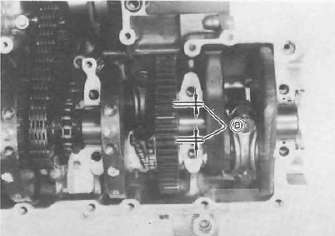
a. 2 — 3 mm (0.08 — 0.12 in) Do not apply sealant
b. The crankcases are assembled by placing the upper case half on the bench and lowering the lower case onto it.
NOTE: Be sure that shift fork No. 2 engages the groove in the 2nd pinion gear on the main axle.
CAUTION: Before installing and torquing the crankcase bolts, check to make sure the transmission is functioning properly by shifting it by hand with the shift cam.

c. Start installation of the crankcase bolts with the center crankshaft area bolts. Place the two bolts without washers in the oil filter area.
d. The crankcase bolts should be torqued in proper sequence. Refer to the tightening sequence in the illustration.

1. Engine ground wire
CRANKCASE TIGHTENING SEQUENCE LOWER CASE

UPPER CASE
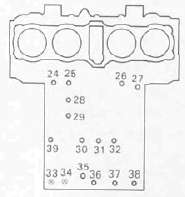
8 mm bolt: 24 Nm (2.4 m kg. 1 7 ft lb) 6 mm bolt: 12 Nm (1.2 m kg. 8 7 ft-lb)
4. Oil pump and strainer cover
a. Place the oil pump drive chain on the transmission main axle.
b. Install the thrust plate onto the transmission main axle.
c. Install the oil pump drive sprocket onto the main axle without the spacer collar and place the oil pump drive chain on its sprocket.

1. Oil pump drive sprocket
d. Place the drive chain on the oil pump driven sprocket and install the pump on the crankase. The "O-ring" should be installe properly.

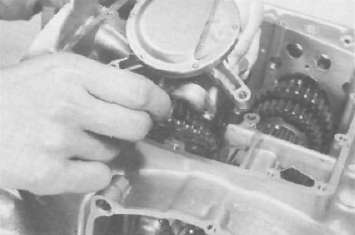
e. Install the drive chain cover on the oil pump and secure with the 2 shouldered bolts and one normal 6 mm bolt.
Tlightening torque:
12 Nm (1.2 mkg, 8.7 ft-lb)
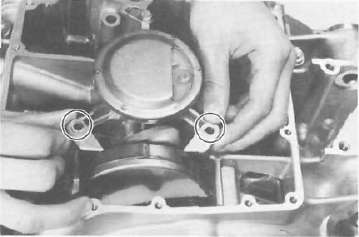
f. Install the strainer cover and torque the bolts to the specification.
Tightening torque:
7 Nm (0.7 m-kg, 5.1 ft lb)
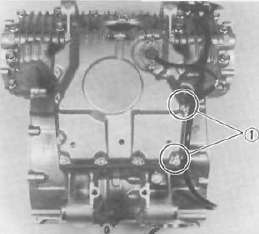
1 Wire clamps
CLUTCH

5. Clutch assembly
a. Insert the spacer coller into the oil pump drive sprocket.
b. Install the primary driven gear (clutch housing) without the bearing and inner spacer.
CAUTION: Be sure that the oil pump drive gear tabs engage the clutch housing grooves on it's back or the tabs will be damaged when tightening the clutch boss securing nut.

1. Spacer collar
c. Install the primary driven gear bearing and inner spacer into the clutch housing.

1 Driven gear bearing 2. Inner spacer
d. Install the large thrust plate and clutch boss onto the main axle.
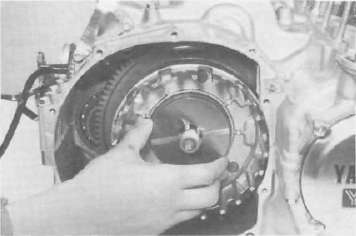
e. Install a new lock washer-and nut and tighten the nut to the specified torque. Use the clutch boss holder (special tool).
Tightening torque:
70 Nm (7.0 nrvkg, 50 ft-lb)

1. Clutch boss holder
f. Bend the lock washer tabs along the nut flats.
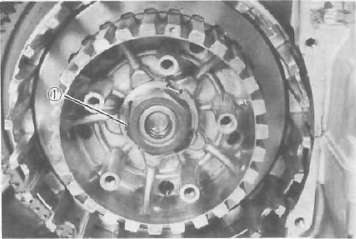
1. Lock tab
g. Install the clutch plates and friction plates alternately on the clutch boss, starting with a friction plate and ending with a friction plate.
h. Install the plate washer, thrust bearing, and clutch pull rod into the clutch pressure plate from inside.

1. Pull rod 2. Thrust bearing 3. Plate washer
i. Install the pressure plate assembly onto the clutch boss.
NOTE: Pressure plate has a dot on it which must line up with the dot on clutch boss.

j. Install the clutch springs and screws. Tighten the screws.
Clutch screw torque: 8 Nm (0.8 m-kg, 5.8 ft lb)
k. Install the oil collector plate.

1. Oil collector plate
I. Set the gear of the clutch pull rod on the pressure plate facing approximately 45° from horizontal toward the rear; set the clutch lever (if installed) on the right crankcase cover parallel to the gasket surface and install the cover to the crankcase. Do not forget to install two dowel pins.

m. If the clutch lever has been removed, install the lever return spring and lever on the shaft after installing the right crankcase cover. In this case make sure that the punch mark on the lever should align with the mark on the crankcase cover when pushing the lever towards the front by hand and then install the circlip.

1 Push
6. Middle gear (installation only, refer to page for the middle gear adjustment). a. Install the middle drive gear assembly with the proper size of shim(s) and secure it with the bearing retainers and new "TORX" screws.
Tightening torque: 25 Nm (2.5 mkg, 18 ft-lb)
b. Stake the screw heads to the dents on the bearing retainers with a center punch.

c. Install the driven gear assembly with the proper size of shims and secure it with the bolts. Apply a thread locking compound such as "LOCTITE" to the bolt threads.
Tightening torque:
25 Nm (2.5 mkg, 18 ft-lb)

1 Shims
d. Install the middle gear case half moon seal onto the crankcase.

1. Seal
Shifter, Generator, Starter and Pickup coils
Shifter, Generator, Starter and Pickup coils7, Shifter assembly
a. Install the shift shaft assembly with the stopper lever.
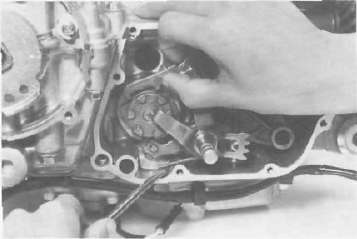
b. Install the shift lever assembly with the positioning spring is properly located on the stopper pin and the teeth should be set properly as shown.
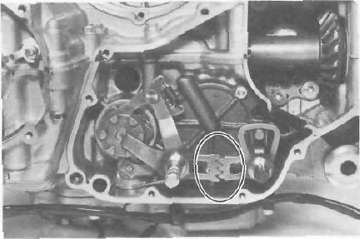
c. Install the left crankcase cover (shifter cover) using a new gasket.
Tightening torque:
12Nm(1.2 mkg, 8.7 ft-lb)
8. A.C. generator a. Install the rotor onto the shaft and tighten the bolt using the rotor holding tool (special tool).
Tightening torque:
55 Nm (5.5 mkg, 40 ft-lb)
b. Install the stator coil assembly onto the crankcase and align the grooves on the stator core with the bolt holes on the crankcase.

c. Install the A.C. generator cover assembly and tighten the bolts to the specification. Do not forget to install the new gasket.
Tightening torque:
12 Nm (1.2 mkg, 8.7 ft-lb)
9. Starter motor
a. Route the A.C. generator leads as shown.
b. Install the starter motor and tighten the bolts to the specification.
Tightening torque: 7 Nm (0.7 mkg, 5.1 ft-lb)
NOTE: Be careful the "O-ring" is not damaged when installing the starter motor.

1 O-ring 2. A. C generator lead
10. Pick-up coil assembly
a. Install the pick-up coil assembly onto the crankcase.
b. Install the timing plate on the crankshaft and tighten the bolt to the specification.
NOTE:
1) Note that there is the locating pin on the crankshaft and the corresponding slot in the timing plate which must be aligned to install the timing plate.
2) Make sure the wire harness clips are properly positioned.


Pistons, Cylinder and Head
Pistons, Cylinder and Head11. Pistons and cylinder
a. Install the pistons on the rods. The arrow on the piston must point to the front of the engine.
NOTE: Before installing the piston pin clips, cover the crankcase with a clean rag so you will not accidentally drop the circlip into the crank-case. Always install new piston pin circlips.

b. Install the rear chain guide on its pivot. Tighten the holding bolt until it stops and then loosen 1/4 turn and then tighten the lock nut

1. Holding bolt 2. Rear cran guide
c. Install the new cylinder base gasket and dowel pins. Install the new "O-rings" to the right side dowel pins.
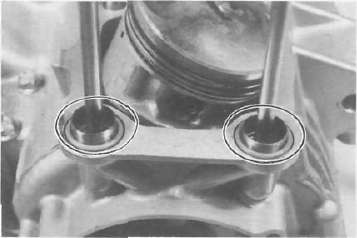
d. Set the crankshaft so that the all pistons are equal height and align the piston rings as shown.
CAUTION: Make sure the ends of the oil ring expanders are not overlapped.
NOTE: Manufacture's marks or numbers stamped on the rings are en the top side of the rings. Coat the pistons and rings well with oil.

e. Install the piston ring compressors (special tool) and piston bases (special tool). Four piston bases are required.

1. Piston bases 2. Piston ring compressors
f. Tie the cam chain with a piece of mechanic's wire and feed it through the chain opening. Carefully lower the cylinder onto the pistons. Remove the ring compressors and piston bases and repeat this procedure for pistons 1 and 4.

g. Install the cylinder securing nut (front side) and tighten it to the specification.
Tightening torque:
20 Nm (2.0 mkg, 14 ft lb)

h. Set the dial gauge on the No. 1 piston head center as shown to find the No. 1 piston top dead center and check whether the "T" mark on the timing plate and stationary pointer are aligned or not. If not, loosen the pointer securing screw and adjust.

CYLINDER HEAD


12. Cylinder head and cam shafts a. Install the new cylinder head gasket. Install the dowel pins and "O-rings". Locate the cam chain cavity cylinder seal with the tabs down.
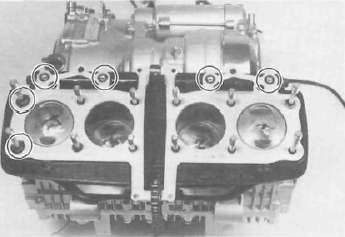
b. Install the cylinder head onto the cylinder. Pull the cam chain through the cylinder head as it is installed. Tie the cam chain so that it does not fall into the crankcase.
c. Place the upper cylinder head nuts and washers in place. Follow the illustration for the proper tightening sequence. Torque all nuts in two stages and final torque the upper nuts to the specification.
Tightening torque:
32 Nm (3.2 mkg, 23 ft lb)
NOTE: Don't forget the lower nuts on the front and rear of the cylinder head. Torque to the specification.
Tightening torque: 20 Nm (2.0 mkg, 14ft-lb)
NOTE: Tighten the nuts in two stages, 1/2 torque value and then full torque value. Also lubricate the bolt threads with the engine oil to achieve proper torque values.
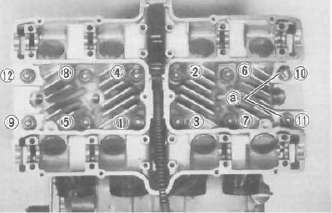
a. Copper washers
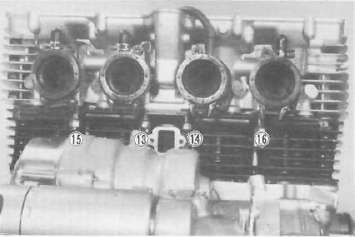

d. Install the front cam chain guide being certain that it is in its holder down below.
e. Rotate the crankshaft counterclockwise direction until the crankcase pointer and "T" mark on the timing plate are aligned.


f. With the cylinders No. 1 and 4 at the top dead center, slip the cam chain over the sprocket.

cj. Lubricate all cam caps and cam bearings surfaces liberally with oil.
h. Place the cam caps in their proper positions. Install the bolts only finger tight.
CAUTION: The cam caps must be tightened evenly or damage to the cylinder head, cam caps and cam will result. The spaces between the caps and cylinder head should be equal.

i. Torque the cam cap bolts in two stages and final torque to the specification.
Tightening torque:
10 Nm (1.0 m-kg, 7.2 ft-lb)
CAM CHAIN

13. Cam chain, cam sprockets and chain tensioner a. Rotate each cam shaft until the dot on the cam is aligned with the hole on the right cam cap.
CAUTION: Use extreme caution when rotating the cams. Two possible dangers exist. First, the wrench may contact the head and fracture it. Or second, a valve may become bent if the cam is turned the wrong way.
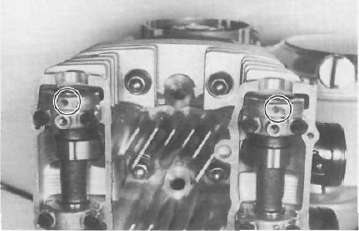
b. Carefully lift the cam chain from the exhaust cam sprocket and pull upward to remove any slack in the chain between the crankshaft and the exhaust cam sprocket. With all slack removed, place the chain back on the cam sprocket.

c. Grip each sprocket simultaneously and place them on the camshaft shoulders while continuing to keep tension on the chain from the crankshaft to the exhaust sprocket
CAUTION: Use only the special hardened shouldered bolts to install the cam chain sprockets to the cams.
Make sure the rollers of the cam chain are centered on both chain guides.
d. Rotate the sprockets slightly to align the bolt holes and insert one special bolt in each sprocket.
NOTE: Tighten only finger tight at this time.
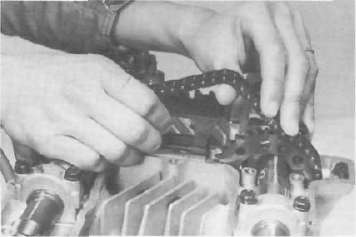
e. Install the center chain guide.
f. Rotate the crankshaft counterclockwise and align the "C" mark on the timing plate with the timing pointer.

g. Remove the end plug and spring from the tensioner assembly.
h. Unlock the oneway cam by pushing it with your finger and push the tensioner rod into the tensioner body until it stops.

i. Install the tensioner to the cylinder and torque the bolts to the specification.
Tightening torque:
10 Nm (1.0 m-kg, 7.2 ft-lb)
j. Reinstall the spring and end plug with the gasket. Torque the end plug to the specification.
Tightening torque:
15 Nm (1.5 m-kg, 11 ft-lb)

k. Rotate the crankshaft more than one full revolution and align the "T" mark on the timing plate with the timing pointer. With the crankshaft at the "T" mark, the dots on the cams should be aligned with the raised holes on the right cam caps. If they are not aligned, disassemble the sprockets and chain tensioner and repeat above procedures.
I. Rotate the crankshaft and install the two remaining shoulder bolts into the cam sprockets. Torque all four sprocket holding bolts to the specification.
CAUTION: Be sure to attain the specified torque value to avoid the possibility of these bolts coming loose and causing serious damage to the engine.
Tightening torque:
20 Nm (2.0 m-kg, 14 ft-lb)

m. Adjust all valves as described in the "PERIODIC INSPECTIONS AND ADJUSTMENTS".
n. Install the cylinder head cover with a new gasket.
o. Install the left and right crankcase covers. The left crankcase cover (pickup coil cover) is required a gasket.
Middle gear servicing
1. Disassembly
Refer to page 3-13 for disassembly.
2. Inspection
Refer to page 3-29 for inspection.
3. Gear lash check
NOTE: The middle gear lash can be checked only when the gears are installed in the crankcase.
a. Install the middle drive pinion holder (special tool) on the crankcase to hold the drive gear stationary during the lash measurement.
NOTE: Before installing the tool, loosen the holder bolt all the way out and after installation tighten this bolt as tight as necessary (finger tight is generally sufficient).

1. Middle drive pinion holder
b. Set the dial gauge to the middle drive flange as shown and gently rotate the drive flange back and forth. Note the lash measurement on the dial gauge.
Middle gear lash: 0.1 ~~ 0.2 mm (0.004 - 0.008 in)

a Middle gear lash
c. Check this engagement at 4 positions. Rotate the drive flange 90° each time and repeat the gear lash check.
NOTE: If the gear lash exceeds the specified limit and adjustment is necessary, the engine or swing arm should be removed from the motorcycle.
4. Gear lash adjustment a. Install the driven gear housing assembly into the crankcase leaving about a 2 mm (0.08 in) gap between the housing and crankcase and install the two bolts to the bearing housing 180° opposite to each other.
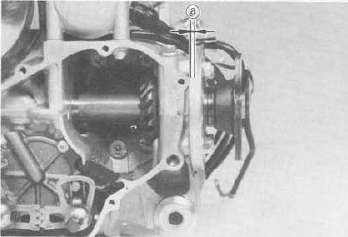
a. 2 mm (0.080 in)
b. Install the middle drive shaft holder and dial gauge (refer to "Middle gear lash check").
c. Slowly tighten the bolts alternately until the dial gauge lash measurement reaches 0.2 mm (0.008 in).
Middle Gear
Middle GearMIDDLE GEAR/DAMPER
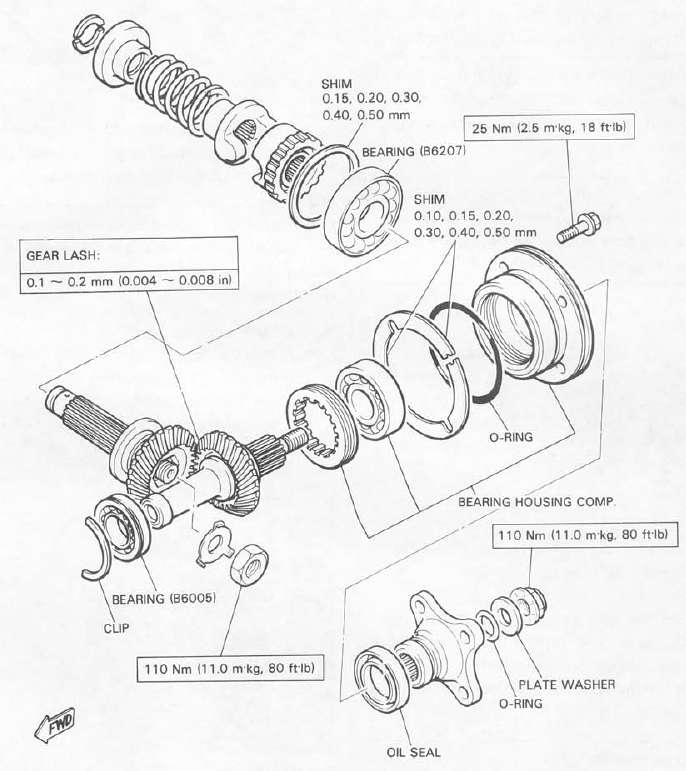

a. Middle gear lash 0 2 mm (0.008 in)
d. Measure the gap between the driven gear bearing housing flange and the crankcase with a feeler gauge. This is the shim size required.
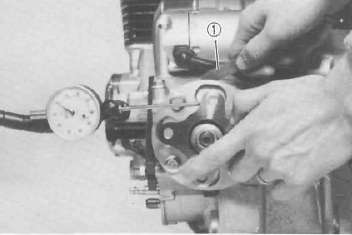
1 Feeler gauge
e. Install the proper sized shims as shown and tighten the driven gear housing to the specified torque. Recheck the gear lash, it should be within the specification, if not readjust the shims.
Gear lash: 0.1 — 0.2 mm
(0.004 — 0.008 in)

1. Shims
5. Drive gear positioning NOTE:
When the following part(s) is replaced with new one(s), drive gear positioning is necessary:
a. Crankcase
b. Middle gears
c. Middle gear bearing housing
a. The shim thickness necessary for the drive gear positioning can be calculated from the infomations found on the upper crankcase and on the drive gear end.

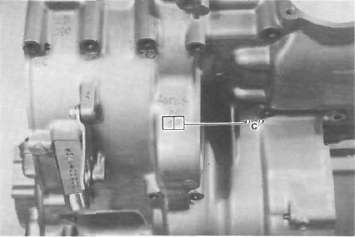
b. To fined shim thickness "A" use the formula:
A = c - a - b
Where:
a = a numeral (usually a decimal number) printed on the shaft end as shown above and either added to or detracted from the nominal size "43".
b = a bearing thickness (considered constant)
c = a numeral (usually a decimal number) found on the upper crankcase half near the main bearing selection numbers and added to the nominal size "60".
Distance "b" = 16.94 mm
Example:
1) If the shaft is marked +03....."a"
is 43.03 mm.
2) "b" is 16.94 mm.
3) If the crankcase is stamped "45" ....."c" is 60.45 mm.
A = c - a - b
A = 60.45 - 16.94 - 43.03
A = 0.48
Then the necessary shim thickness
is 0.48 mm. c. Shim size are supplied in the following thicknesses:
0.15 mm, 0.20 mm, 0.30 mm, 0.40 mm, and 0.50 mm.
Because the shims can only be selected in 0.05 mm increments the following chaft should be used when encountering last digits that are not 5 or zero(0):
|
Last digits |
Rounding |
|
0, 1,2 |
0 |
|
3, 4, 5, 6, 7 |
5 |
|
8,9 |
10 |
Shim 0.30 mm + 0.15 mm
Reinstalling Engine
Reinstalling EngineRemounting engine
1. Assembly is the reverse the applicable removal steps.
CAUTION: Always use new bolts in the drive shaft coupling.
2. Install and tighten the engine mounting bolts-
Engine mounting bolt torque: 8 mm bolt:
20 Nm (2.0 m-kg, 14 ft-lb) 10 mm bolt:
42 Nm (4.2 m-kg, 30 ft-lb) 12 mm bolt:
70 Nm (7.0 m-kg, 50 ft-lb)
3. Install a new "0-ring" and install the oil cooler spacer to the crankcase. Make sure the "0-ring" is positioned properly.
Oil cooler spacer bolt torque: 50 Nm (5.0 m-kg, 36 ft-lb)
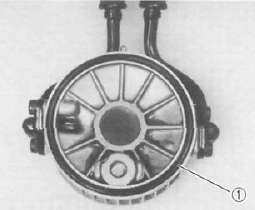
1. 0-ring
4. Install a new "O-ring". Make sure the "O-ring" is positioned properly.
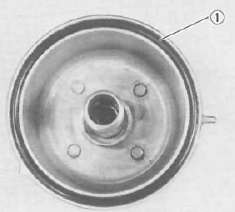
1 O-ring
5. Install the oil filter element into the filter cover.
Oil filter mounting bolt torque: 15 Nm (1.5 m-kg, 11 ft lb)
6. Install and tighten the engine oil drain plug and middle gear drain plug.
Engine oil drain plug torque: 43 Nm (43 m-kg, 31 ft-lb)
Middle gear drain plug torque: 16 Nm (1.6 m-kg, 11 ft-lb)
7. Add oil to the engine and middle gear case.
Oil quantities: 3.6 L (3.2 Imp qt, 3.8 US qt)
NOTE: The oil quantities are for an overhauled engine.
OIL COOLER
